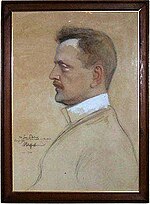
Summary
King Christian II (Swedish: Kung Kristian II), Op. 27, is incidental music by Jean Sibelius for the Scandinavian historical play of the same name, written by his friend Adolf Paul. The original play deals with the love of King Christian II, ruler of Denmark, Sweden and Norway, for a Dutch girl, Dyvecke, a commoner. Sibelius composed in 1898 seven movements. He conducted the first performance of the first four parts the Swedish Theatre in Helsinki on 24 February 1898. In the following summer, he composed three more movements, Nocturne, Serenade and Ballad. The Nocturne was an interlude between the first act and the second. The position of the serenade changed. The ballad is a dramatic piece about the Stockholm Bloodbath (1520). This movement shows already traits of the later First Symphony. The stage music consists of the following numbers:
- Elegia
- Musette
- Menuetto
- Sången om korsspindeln
- Nocturne
- Serenade
- Ballade.[1]
| King Christian II | |
|---|---|
| Incidental music by Jean Sibelius | |
 The composer in 1904, by Albert Edelfelt | |
| Opus | 27 |
| Composed | 1898 |
| Performed | 24 February 1898 |
| Scoring | orchestra |

Sibelius derived from the incidental music a suite of five movements.[2] A complete performance of the suite takes about 25 minutes. It was first performed in December 1898, conducted by Robert Kajanus. Sibelius wrote in a letter: “The music sounded excellent and the tempi seem to be right. I think this is the first time that I have managed to make something complete.”
Movements of the suite edit
The suite consists of five movements:
| Movement | Type | Tempo | Notes |
|---|---|---|---|
| 1 | Nocturne | Molto moderato | A love scene. |
| 2 | Elegy | Andante sostenuto | The original introduction to the incidental music. Scored only for strings. |
| 3 | Musette | Allegretto | Dyvecke's dance. Originally scored for clarinets and bassoons, but with strings added for the suite. |
| 4 | Serenade | Moderato assai (Quasi menuetto) | Taken from the prelude to the third act of the play (music for the court ball). |
| 5 | Ballade | Allegro molto | The tempestuous music reflects the anger of the King. |
References edit
External links edit
- King Christian II (incidental music): Scores at the International Music Score Library Project
- King Christian II (suite), Op.27: Scores at the International Music Score Library Project


